How to Advertise on Facebook: The Complete Guide
Table of contents
Why advertise on Facebook?
Types of Facebook ads
Facebook ads: Guidelines and examples
How to advertise on Facebook: Placing your ad
Facebook advertising tools
Facebook ads best practices
Facebook advertising campaign ideas
Why advertise on Facebook?
At last count, more than two billion people were using Facebook. And those users are highly engaged with the content posted on the network: More than 800 million people like something on Facebook every single day.
Of course, when it comes to getting the biggest bang for your advertising buck, too large an audience can actually be a bad thing. After all, you only want to pay to expose your brand to people who might be interested in doing business with you. Fortunately, Facebook offers multiple layers of targeting, so you can focus your Facebook ads on exactly the right audience for your business to maximize ROI.
We’ll get into the specifics of targeting Facebook ads later on in this post, but for now keep in mind that Facebook’s huge, global audience combined with the ability to target your ad by demographics, location, interests, and behaviors allows you to access the exact people who are most likely to want to buy your products or services.
Need more convincing? Consider this: 95.8 percent of social media marketers worldwide said Facebook provides the best ROI of all social platforms.

Perhaps it’s no surprise, then, that close to two-thirds of advertisers worldwide plan to increase their Facebook advertising spend in 2017.

With your competitors already seeing meaningful results from Facebook ads and increasing their spend, it’s high time to develop a Facebook advertising strategy of your own.
Types of Facebook ads
Facebook offers 10 campaign objectives based on what you want your ad to accomplish. For each of those objectives, you can choose various ad formats based on your chosen goal and target audience.
Before we dig into some specific Facebook ad examples and the technical requirements for each format, let’s take a quick look at how the different types of Facebook campaigns align with business goals:
- App installs: Encourage installations of your mobile or desktop app.
- Brand awareness: Introduce your brand to a new audience.
- Conversions: Get people to take a specific action on your website (like subscribe to your list or buy your product).
- Engagement: Expose a post to a wide audience to increase the number of Likes, comments, shares, or photo views; increase your number of Page Likes; promote an event.
- Lead generation: Get new prospects into your sales funnel.
- Reach: Expose your ad to as many people in your audience as possible.
- Product catalog sales: Connect your Facebook ads to your product catalog to show people ads for the products they are most likely to want to buy
- Store visits: Drive customers to brick-and-mortar stores.
- Traffic: Drive traffic to a specific webpage.
- Video views: Show your video to a large audience to increase brand awareness.
Facebook ads: Guidelines and examples
Now that you understand the various Facebook campaign objectives, let’s explore the various Facebook advertising formats.
Photo Facebook ads
- Facebook ad specs: One image plus text
- Campaign types: All except video views
- Facebook ad image sizes: 1200 x 628 pixels
- Text limit: 90 characters
- Headline text limit: 25 characters
Note: Since Facebook doesn’t want people’s newsfeeds to be filled with text-heavy images screaming for attention, you need to keep your text overlays to less than 20 percent of your image. (This also applies to video thumbnails.) In fact, the less text there is on your image, the more widely it will be distributed. Use this tool by Facebook to check if your images contain less than 20 percent text.
Simple photo ads don’t have to be boring. Dallas bookstore The Wild Detectives used photos ads with clickbait-style headlines to trick people into reading classic literature.
The strategy worked like gangbusters: the bookstore saw a 14,000 percent increase in site traffic, and the campaign won a 2017 Facebook Award.
Video Facebook ads
- Facebook ad specs: One video plus text
- Campaign types: All
- Facebook ad image sizes (thumbnail): Minimum width 600 pixels; match length to video aspect ratio
- Text limit: 90 characters
- Headline text limit: 25 characters
- Facebook ad dimensions: Video aspect ratio of 16:9 (full landscape) or 1:1 (square) for all objectives; other aspect ratios available for specific campaign types
- Maximum video length: 120 minutes
Video ads can create massive engagement—if they’re done right. A video about bread could be, well, a little boring. Not this one! At the time of writing, this Facebook video ad for Dave’s Killer Bread had more than 2,500 shares and more than 1,200 comments.
Slideshow Facebook ads
- Facebook ad specs: A video automatically created from up to 10 still images
- Campaign types: All except post engagement and product catalog sales
- Facebook ad image sizes: 1280 x 720 pixels
- Text limit: 90 characters
Activewear company Carbon38 found that compared to Facebook photo ads, Slideshow ads saw an 85 percent increase in return on ad spend and had a 40 percent higher click-through rate.
Facebook Carousel ads
- Facebook ad specs: Up to 10 photos or videos plus text
- Campaign types: All except post engagement and product catalog sales
- Facebook ad image sizes: 600 x 600 pixels
- Text limit: 90 characters
- Headline text limit: 40 characters (for images) or 25 characters (for video)
- Maximum video length: Two minutes combined
The knitting and crochet supply site Kitterly uses Carousel ads to retarget potential customers with products they have already viewed on the Kitterly website, resulting in a 3.4 times return on ad spend.
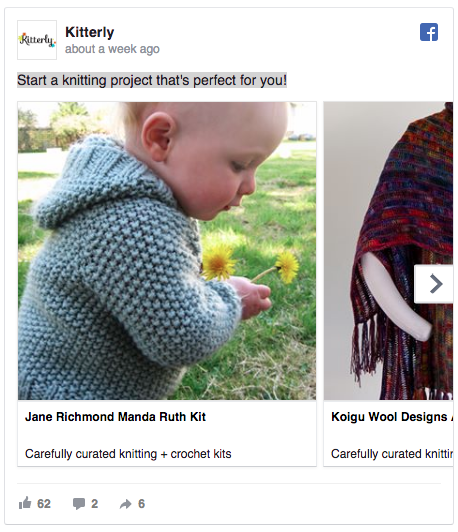
Facebook Collection ads
- Facebook ad specs: A mobile-only ad format that showcases multiple products or features
- Campaign types: Conversions, traffic
- Facebook ad image sizes: 1200 x 628 pixels
- Facebook ad dimensions: Video aspect ratio of 16:9 (full landscape) or 1:1 (square)
- Headline text limit: 25 characters
- Maximum video length: 120 minutes
When MeUndies launched a Collection ad, it increased its conversion rate by 40 percent.
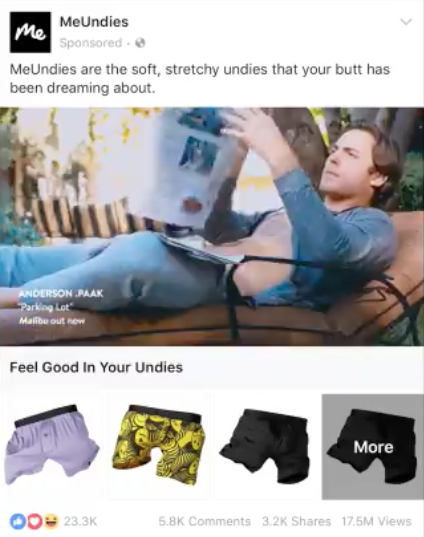
Facebook Canvas ads
- Facebook ad specs: An immersive ad format incorporating text, up to 20 photos, and video
- Campaign types: Brand awareness, conversions, engagement
- Facebook ad size: Full screen
- Facebook ad image sizes: 66 x 882 pixels (header); 1080 x 1920 pixels (full-screen image)
- Text limit: 500-character text bock
The Montana Office of Tourism Development used Canvas to highlight the region’s stunning scenery and ski destinations and increased their click-through rate by 7.5 times.
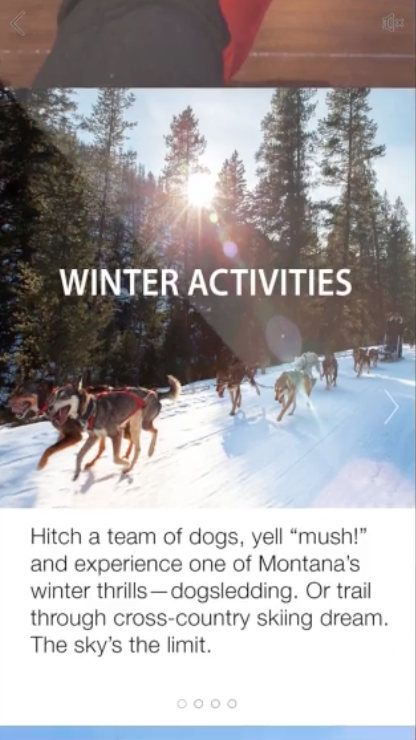
Facebook Lead ads
- Facebook ad specs: A pre-filled lead form that makes it easy to connect people with your business
- Campaign types: Lead generation
- Facebook ad image sizes: 1200 x 628 pixels
- Headline text limit: 45 characters
- Button text limit: 25 characters
Maserati USA used lead ads to collect 21,000 leads, resulting in sales of 127 vehicles.
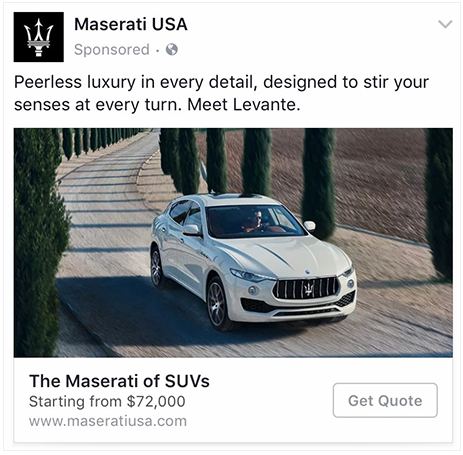
For more great example of Lead Ads in action, check out our blog post on seven smart ideas to grow your business with Facebook Lead ads.
How to advertise on Facebook: Placing your ad
If you already have a Facebook business page (and you should), you can head straight to the Facebook Ads Manager to create your Facebook ad campaign. If you don’t yet have a business page, you’ll need to create one first.
Step 1: Choose your campaign objective
Choose your campaign objective based on the most important metrics for your business and your goals for this particular ad.
Keep in mind that for conversion-oriented objectives you can pay per action, but for exposure objectives you will pay for impressions.
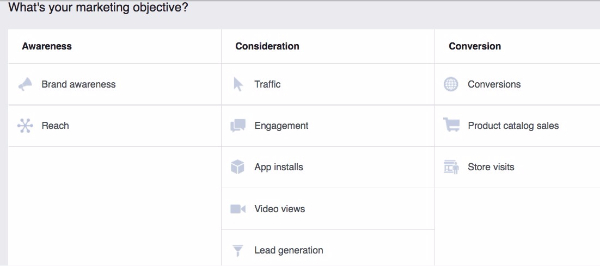
Step 2: Target your audience
Remember: Effective targeting is key to maximizing ROI—and there’s no shortage of ways to target your audience on Facebook. In addition to targeting by location, gender, and online behaviors, you can hone your audience based on the following:
Connections: You can target people who are either connected or not connected to your Facebook Page. If you want to reach a new audience, under Detailed Targeting, choose select “Exclude people who like your Page.” If you want to promote an offer or new product, select “People who like your Facebook Page” to reach people who already know your brand.
Custom Audiences: You can build your own audience of people who have already interacted with your business on or off Facebook. Facebook has a good step-by-step guide on how to do this.

Lookalike Audiences: This lets you target people who are similar to your existing most valuable audiences. Here’s how to set-up a Lookalike Audience.
For advanced Facebook ads audience research and targeting tactics, check out this video:
As you make your selections, keep an eye on the meter on the right side of the page, which indicates the breadth of your audience selection, and the estimated daily reach chart.

Step 3: Set your budget and schedule
Next, you decide how much money you want to spend on your Facebook ad. You can choose a daily or lifetime budget, then set the start and end dates if you want to schedule your ad in the future, or choose to place it live right away.
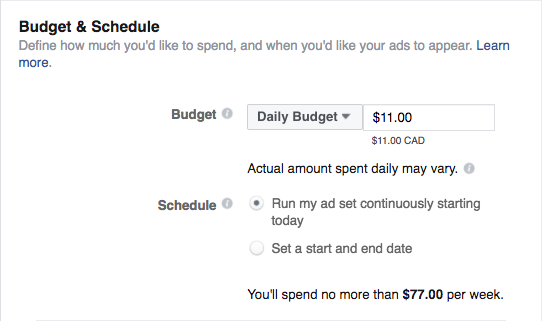
You can get into pretty fine detail about how you want to spend your money using the advanced budget options.
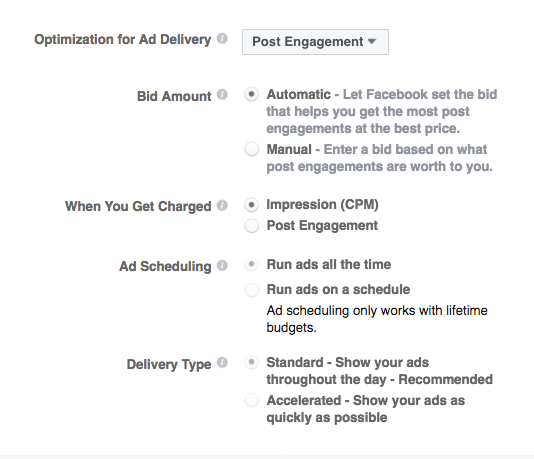
Keep in mind that running your ad on a schedule may be the most efficient way to spend your ad budget, since you can choose only to serve your ad when your target audience is most likely to be on Facebook.
Step 4: Create your Facebook ads
One option is to promote an existing post. If you would prefer instead to create a new ad, first choose your ad format, then enter the text and media components for your ad. Making sure you conform to the Facebook ad image sizes mentioned above for each format.

Use the preview tool at the bottom of the page to make sure your ad looks good for all potential placements (mobile, desktop news feed, right column, and so on). When you’re happy with your choices, click the green Confirm button to submit your order, then wait to get an email from Facebook notifying you that your ad has been approved.
Bonus: Download a free guide that teaches you how to turn Facebook traffic into sales in four simple steps using Hootsuite.
Facebook advertising tools
Hootsuite Ads
Rather than placing each ad manually, with Hootsuite Ads, you can create and test hundreds of ads in minutes, automatically boost budgets based on performance triggers, and control who can create and edit campaigns.
You can also choose organic posts to promote directly within the Hootsuite dashboard, so you can extend the reach of your best-performing content.
AdEspresso
While Hootsuite Ads is an enterprise-grade solution, AdEspresso by Hootsuite is a self-serve social ad management solution designed specifically for small and mid-sized organizations. It also allows you to create ads and monitor the results directly from the Hootsuite dashboard.
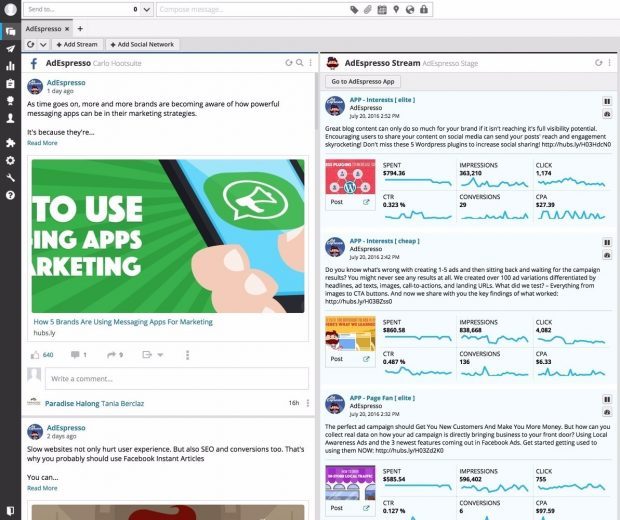

Facebook ads best practices
Keep these important strategies in mind to make the most of your Facebook advertising efforts.
Experiment with audience targeting
Start with a narrow audience and then broaden it slowly by adding one interest category at a time. For example, you could start with an audience specifically interested in “Napa Valley wine tours” and then broaden after a few weeks, adding “wine tasting,” “food and wine,” and so on. That way, you’ll have a good idea of what’s moving the needle.
If you have a local business, you can target your audience by zip or postal code. This is also helpful if you know a particular city or neighborhood converts well.
PRO TIP: Mikie Basi, a digital marketing strategist at Hootsuite, offers this advice: “Always test different types of targeting to find the best audience for your products. Experiment with interest categories, friends of followers, and website audience lookalikes. Run them in separate ad sets to determine which is the top performer.”
Rotate your ads regularly
“Ad fatigue”—or reduced engagement—can occur when people see the same ad too many times. Rather than bombarding your audience with the same ad over and over, switch it up so they are exposed to different elements of your brand offering. Facebook recommends switching your ad once every one to two weeks.
Test everything
Facebook ads are a perfect venue for learning what resonates best with your audience, from ad format to image style to hashtags to length of copy and tone of voice. Since testing is such an important topic, we’ve got a whole guide on how to do it.
Use a Facebook Pixel
A Facebook pixel is a small piece of code that can have a big impact on your Facebook advertising campaigns. Once you place the code on your website, it will allow you to track conversions, remarket to people who have viewed a product on your website, and create lookalike audiences.
We’ve got a blog post to help you get set up with the Facebook pixel: The Facebook Pixel: What It Is and How to Use It.
Include a call to action
You know what the goal of your Facebook ad is—but do your viewers? Including a call to action (CTA) ensures that the people who see your ad understand what the next step is in developing a relationship with your company. Check out our guide on how to create effective CTAs.
Use top-notch photos and video
You know what’s a turnoff? Blurry photos. Or pixelated photos. Or jumpy videos that make you feel motion sick. Your words are important, sure, but your visuals are what will first grab viewers’ attention and create the first impression.
Make sure you comply with the Facebook ad image sizes for each format, specified above, for the best results. These free stock photo websites can help you source high-quality images to use in your ads.
If you sell a product, Facebook recommends that you try using photos showing people using and benefitting from your product, rather than an image of the product all by its lonesome.
If you sell a product, Facebook recommends that you try using photos showing people using and benefitting from your product, rather than an image of the product all by its lonesome.
Facebook advertising campaign ideas
Raring to go but not sure what you should promote with your Facebook ads? We’ve put together three campaign strategies to get your started.
Facebook advertising strategy 1: Collect an email
Unless you’re a marketing magician, it’s pretty hard to get people to buy from you the first time you wave to them in a Facebook ad.
For products that take longer to sell, email is your best friend. Facebook makes it pretty simple to collect new email leads. With software such as MailChimp, you can send out automatic emails (say, one email every few days). This helps you build trust and introduce people to your brand before you pitch your product.
STEP 1: In Facebook Ads Manager, choose “Lead Generation” as your campaign objective.
STEP 2: When you create your lead form, choose fields that align with the fields on your email list. Keep it simple: first name, last name, and email address.
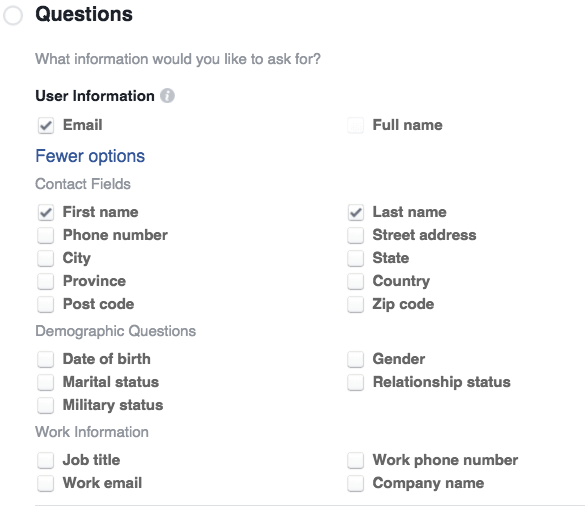
STEP 3: Use the tool Zapier to automatically send email sign-ups from your Facebook campaigns to your email provider, such as MailChimp. You’ll need to sign up for a Zapier account and connect Facebook to Zapier. Here’s a step-by-step guide for MailChimp users.
STEP 4: Do a quick test to make sure data is passing between Facebook and MailChimp.
STEP 5: Launch your ad campaign and watch the emails come rolling in. If you want to get more sophisticated, you can set up a custom automated email sequence in your email provider for Facebook leads. Below is a quick email strategy to use. You can sequence these emails a few days apart:
Automated Email No. 1—Share something really valuable that connects to the problem your product solves (example: a food truck could share a map of all the best restaurants in the city). No product pitch. Just value. You’re training prospects to open your emails.
Automated Email No. 2—Tell an interesting story that connects to your product. For example, the food truck could talk about how they couldn’t find a good Pho/Italian fusion restaurant and so quit their corporate jobs and created their food truck, Pho Get About It.
Automated Email No. 3—Share another valuable resource (such as five mistakes people make when cooking spicy chicken at home). No product pitch.
Automated Email No. 4—Make an offer such as a discount for their first visit.
Automated Email No. 5—Make the same offer again but tell an interesting and useful story as the lead.
The goal is always the same: train people to open your emails by offering valuable content and then make the occasional product pitch.
The Milwaukee Bucks NBA team used this strategy to boost its season ticket sales. The team ran lead ads targeted to Custom Audiences of past season ticket holders, fans of their Facebook Page, and other existing leads.
They also used lookalike audiences modeled on current season ticket holders, while excluding current ticket holders so they would not waste ad exposure on people who had already purchased their tickets.
Finally, they used interest targeting (sports fans) and location targeting to make sure people who saw the ads would be interested in the team and able to make it to the games if they bought tickets.
The collected leads went directly into the team’s CRM and kicked off a series of emails. After the email series, sales reps followed up in person with those who had not bought tickets.
The results? The team saw a 25 percent higher email open rate than usual and more than double their usual email click-through rate, with 33 percent of leads buying the advertised ticket packages and 20 buying upgraded tickets.
Facebook advertising strategy 2: Convert a proven piece of content into a video ad
Every brand has a few killer pieces of content that drive the lion’s share of traffic each month. Adapting that content into a short video aimed at Facebook audiences can be a great way to repackage top content for Facebook ads.
STEP 1: Distill the key ideas from your content piece into a few key points you can express in a few words each, or think about ways to convey the same key messages through your visuals. Make sure your call to action matches your video content.
STEP 2: Use one of these social video tools to create your video, or create a slideshow video ad in Facebook Ads Manager.
STEP 3: In Facebook Ads Manager, select “Video Views” as your campaign objective. Upload your video directly to Facebook and push the campaign live.
Repurposing great blog content as social video is a favorite strategy at Hootsuite, so you can see lots of great examples on the Hootsuite Facebook Page. For instance, our video team repurposed this blog post on how to optimize Facebook video to play without sound into the following Facebook video:
PRO TIP: What types of videos work best on Facebook? How can you take someone from a video view to a lead or sale? We created a video strategy kit for marketers, showing what types of videos work best on social media and what to measure.
Facebook advertising strategy 3: Drive a direct sale
If you have a good product, there’s no reason why Facebook can’t generate direct sales. But when asking for a direct sale, you need trust—so if you’re an unknown brand with an untested product, it’s probably best to test the first two Facebook advertising strategies first.
If you’re confident that people will buy your product directly from a Facebook ad and you have a proven product with sales, test this strategy and be sue to measure your results.
STEP 1: In Facebook Ads Manager, select “Conversions” as your campaign objective.
STEP 2: Next, Facebook will ask you which type of conversion event you want to track, such as adding products to a shopping cart or adding payment information. Since you’re trying to drive a direct sale, select “Purchase.” You’ll need to install a Facebook Pixel to track a visitor from your Facebook ad all the way through your shopping cart process to purchase.
STEP 3: Create your ad with simple and clear copy. What do you offer and how is it different? Give people a reason to buy from this specific ad. For example, maybe you bundle another product as a freebie, or include a training webinar. You want people to stop what they are doing and click from your ad to your shopping cart.
STEP 4: Wait and track. Give your campaign at least two weeks before making any changes to copy or creative. Depending on your traffic volume, this should give you enough data to make an educated decision about what’s working, or what changes you might want to test.
Charge Cords used Facebook ads to drive direct sales from new customers, using Custom Audiences to exclude people who had already bought from them in the last six months. They used Carousel ads with eye-catching product shots and compelling ad copy, along with a Shop Now call-to-action button. As the campaign continued, they updated the Custom Audience to target people who had visited the Charge Cords website.
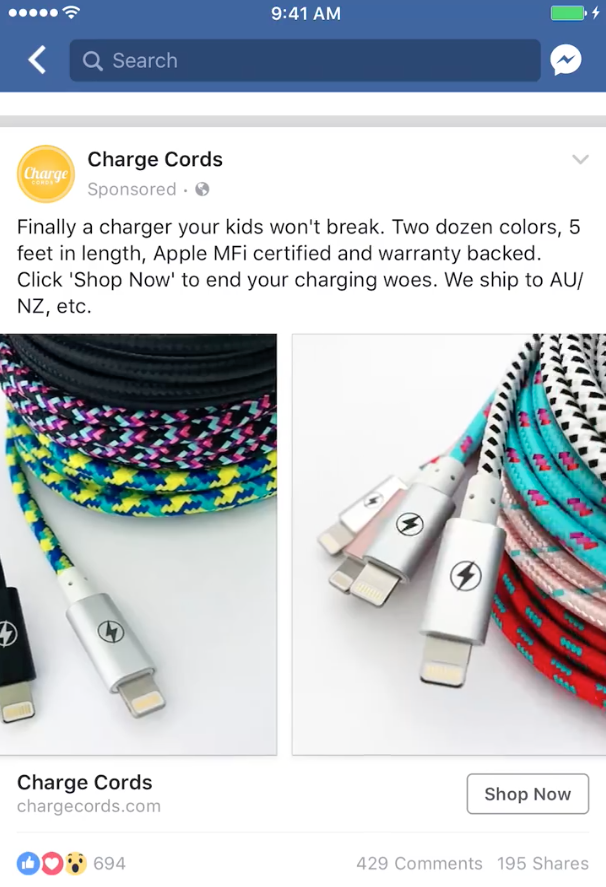
The campaign resulted in a four times increase in sales from the targeted countries, and a four times return on ad spend.
PRO TIP: With remarketing, you can serve Facebook ads to people who have already visited your website. Your ads could include enticing offers, product recommendations, or funny reminders to complete their purchase. We cover remarketing with the Facebook pixel in our blog post on surprising ways to optimize your Facebook ads.
No comments:
Post a Comment